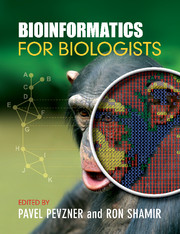Book contents
- Frontmatter
- Contents
- Extended contents
- Preface
- Acknowledgments
- Editors and contributors
- A computational micro primer
- PART I Genomes
- 1 Identifying the genetic basis of disease
- 2 Pattern identification in a haplotype block
- 3 Genome reconstruction: a puzzle with a billion pieces
- 4 Dynamic programming: one algorithmic key for many biological locks
- 5 Measuring evidence: who's your daddy?
- PART II Gene Transcription and Regulation
- PART III Evolution
- PART IV Phylogeny
- PART V Regulatory Networks
- REFERENCES
- Glossary
- Index
1 - Identifying the genetic basis of disease
from PART I - Genomes
Published online by Cambridge University Press: 05 June 2012
- Frontmatter
- Contents
- Extended contents
- Preface
- Acknowledgments
- Editors and contributors
- A computational micro primer
- PART I Genomes
- 1 Identifying the genetic basis of disease
- 2 Pattern identification in a haplotype block
- 3 Genome reconstruction: a puzzle with a billion pieces
- 4 Dynamic programming: one algorithmic key for many biological locks
- 5 Measuring evidence: who's your daddy?
- PART II Gene Transcription and Regulation
- PART III Evolution
- PART IV Phylogeny
- PART V Regulatory Networks
- REFERENCES
- Glossary
- Index
Summary
It is all in the DNA. Our genetic code, or genotype, influences much about us. Not only are physical attributes (appearance, height, weight, eye color, hair color, etc.) all fair game for genetics, but also possibly more important things such as our susceptibility to diseases, response to a certain drug, and so on. We refer to these “observable physico-chemical traits” as phenotypes. Note that “to influence” is not the same as “to determine” – other factors such as the environment one grows up in can play a role. The exact contribution of the genotype in determining a specific phenotype is a subject of much research. The best we can do today is to measure correlations between the two. Even this simpler problem has many challenges. But we are jumping ahead of ourselves. Let us review some biology.
Background
Why do we focus on DNA? Recall that our bodies have organs, each with a specific set of functions. The organs in turn are made up of tissues. Tissues are clusters of cells of a similar type that perform similar functions. Thus, it is useful to work with cells because they are simpler than organisms, yet encode enough complexity to function autonomously. Thus, we can extract cells into a Petri dish, and they can grow, divide, communicate, and so on. Indeed, the individual starts life as a single cell, and grows up to full complexity, while inheriting many of its parents' phenotypes.
- Type
- Chapter
- Information
- Bioinformatics for Biologists , pp. 3 - 22Publisher: Cambridge University PressPrint publication year: 2011

